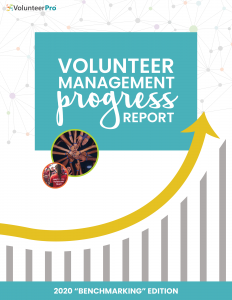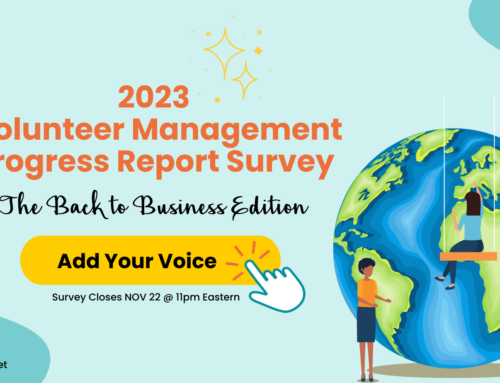 Best Practices for Volunteer Programs: How to Inspire Innovation
Best Practices for Volunteer Programs: How to Inspire Innovation
I’m a person drawn to research and learning new, creative ways to think about my purpose and path in life. Currently, I am learning about astrology and lunar cycles and how I can work with both to commit to myself and the opportunities I want to create in my life. While you may not be drawn to the celestial side of things (it’s not for everyone, I get it!), chances are that you are captivated by some exciting best practices for volunteer programs that challenge the way you have always done things in your nonprofit.
That said, best practices are still widely disregarded by leadership teams. Although they are discussed in meetings, written about in reports or grant applications, and published in newsletters and studies, many of the best practices you are drawn to are merely pushed aside by your leadership team.
Why are the new ideas you keep bringing to the table not getting the attention they deserve?
Read on for common barriers in adopting best practices, and their possible solutions, so that the next time you bring up a tried and true technique to an organizational problem, you will have the buy-in you need from leadership to put it into practice.
Barrier #1— What Is a Best Practice Anyways?!
If you Google “best practices” you are going to get a few different definitions; however, the most important aspect of those definitions (and one that is missing from most) is that a best practice is backed by research. If you are looking into best practices for volunteer programs and find an idea you want to implement in your organization, make sure you find proof that it works!
Your leadership team thinks strategically before spending time, energy, and resources on any new ideas they are bringing to the organization, and the same needs to be true for you.
What’s your solution?
 Define what a best practice means to you and your volunteer program.
Define what a best practice means to you and your volunteer program.
Perhaps you want your best practices to be innovative, proven, and sustainable, all of which are aspects that will appeal to leadership. Gather your research before you present the idea to leadership and ensure you have the knowledge, tools, and time it will take to implement the change.
Knowing how and why this change is going to have a positive impact on your organization will amplify its credibility in your leadership’s eyes, and will have a better chance at being accepted into your program.
Barrier #2— No System, No Go
It’s no secret that nonprofits are underfunded, under-resourced, and under a lot of stress trying to accomplish lofty goals for their communities. However, that shouldn’t be an excuse for nonprofit staff to fly by the seat of their pants, learning as they go!
When it comes time for you to implement a new best practice for your volunteer program, you must have a consistent system put in place that will track the process of implementation and the metrics that will inform you if your tactics are working.
Another benefit of putting a system in place is the retention of knowledge. If the implementation process lives in someone’s mind and they aren’t tracking their progress, what happens to that knowledge should they leave the organization? Most likely, it leaves with them.
What’s your solution?
 Use project management software to track your process and progress on every best practice you are currently implementing at your organization. Include every nitty-gritty detail from supportive documents, case studies, tools, tasks, due dates, and metrics you want/need to track.
Use project management software to track your process and progress on every best practice you are currently implementing at your organization. Include every nitty-gritty detail from supportive documents, case studies, tools, tasks, due dates, and metrics you want/need to track.
Once you have a fully fleshed-out system in place, couple it with the how and why you determined in the last step, and leadership will be more likely to jump on board with your plan.
Barrier #3— What’s in it for the Organization?
Convincing leadership to take a chance on something new and innovative when it may take months or even years to see a return on investment can be challenging.
Management will often focus on how this change will benefit the organization immediately versus the long-term gains. Many decision-makers are also facing workplace politics, lack of time, and slow decision-making processes which may impede your ability to sell change.
What’s your solution?
Mention what other organizations are doing, how they are doing it, and the immediate and long term results the change brought about. You will have a list already, due to your diligent research! Compare what they did to what you can do and show how it will help your organization, both in the short and long term.
This tactic can trigger a fear of missing out response, and your leadership team will want in on the rewards and trust your input and value to the organization.
What is Your Organization Lacking?
In a Harvard Business Review post, Ron Ashkenas noted two barriers to applying best practices successfully:
- Lack of adaption— Don’t fall victim to taking on a new idea without adapting it to your organization’s needs and goals! If you want to create change in your organization based on the success of a different organization, you need to tailor it to your volunteer program, your mission, and your work style. When you get ready to present your idea to leadership, show examples of how the other organization developed the change and adapt their process based on your organization’s priorities, strengths, challenges, and opportunities.
- Lack of adoption— When it comes to big decisions, don’t create major changes first and ask for permission later! Implementing a new process, no matter how much evidence you have to back its success, without full leadership support and commitment guarantees you will fall short of your goals. If you lack support from leadership from the get-go, and you encounter any hint of a challenge in executing your plan, they’ll be the first to jump in and tell you to abandon ship. It will also be harder for you to convince them in the future that you have done your due diligence and they should buy-in to your plan.
Looking for More Inspiration?
 Are you looking to bring innovative change to your nonprofit using best practices for volunteer programs, but you’re not sure where to start?
Are you looking to bring innovative change to your nonprofit using best practices for volunteer programs, but you’re not sure where to start?
Download the full 2020 Volunteer Management Progress Report and see how your organization’s volunteer program stacks up with thousands of others around the world.




